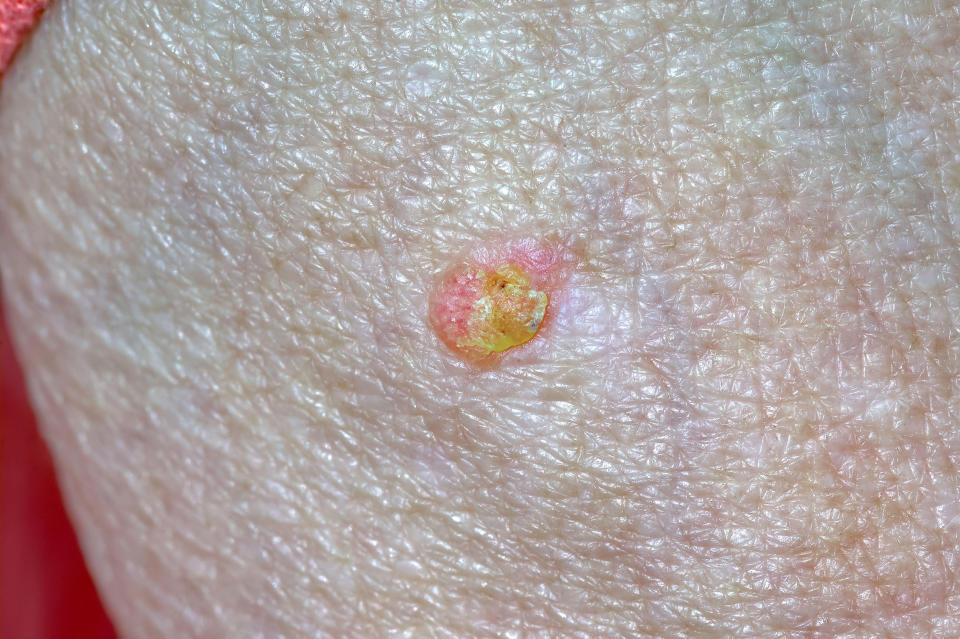Do you have dry skin that never gets better? It may be a precancerous condition
What is actinic keratosis? An actinic keratosis is a precancerous skin lesion. These lesions often appear as rough spots on the skin and are caused by sun exposure or indoor tanning. Untreated, they can turn into a type of skin cancer called squamous cell carcinoma. The American Academy of Dermatology (AAD) estimates that 40 million people in the U.S. develop actinic keratoses each year.
“They are extremely common. I see them multiple times a day in my office,” said Dr. Allison Arthur, a dermatologist and dermatopathologist at Sand Lake Dermatology Center in Orlando, Florida, and a member of the American Academy of Dermatology. “They typically feel like sandpaper. They have a rough, scaly texture. But unlike dry skin they don’t go away with moisturizers.”
Watch TODAY All Day! Get the best news, information and inspiration from TODAY, all day long.
Symptoms of actinic keratosis
An actinic keratosis typically shows up on the face or other parts of the body that get exposed to the sun. “We see them more frequently on chronically sun-exposed areas like the face, forearms and the backs of the hands,” said Dr. Laura Ferris, associate professor and director of clinical trials in the dermatology department at the University of Pittsburgh Medical Center and a member of the American Academy of Dermatology.
Their rough texture means they are often easier to feel than to see, according to the American Osteopathic College of Dermatology (AOCD). They may itch or feel prickly, especially after sun exposure.
When actinic keratoses are visible, they can show up in various ways, according to the AAD.
Alert your dermatologist if you notice:
Bumps that look like pimples or acne
A group of spots that looks like a rash
A red, pink or gray raised area
A discoloration that looks like an age spot
A growth that looks like an animal horn

Actinic keratosis on the lips is called actinic cheilitis.
It could look like:
Chapped lips that don’t heal
White patches
A change in color where the lips start to match the color of the face
Causes of actinic keratosis
An actinic keratosis can develop after ultraviolet light from the sun or from indoor tanning damages cells in the skin called keratinocytes, according to the AAD. They’re most often diagnosed in people aged 50 and older who’ve had a lot of sun exposure, though they can show up in younger people.
According to the AAD, you’re at higher risk for actinic keratoses if you:
Have fair or albino skin
Have red or blond hair
Rarely protected your skin from the sun
Have tanned indoors
Received an organ transplant
Have a weakened immune system or certain health conditions, such as xeroderma pigmentosum, Rothnord-Thomson syndrome or Bloom syndrome
"People with darker skin types tend to have fewer actinic keratoses than those with lighter skin tones because they have more natural protection from the sun," said Arthur. Ferris added that though Black patients are at lower risk of actinic keratosis, the lesions "appear the same when they occur."
Diagnosing actinic keratosis
If you suspect you might have actinic keratosis, see your dermatologist. “Sometimes people will say, ‘I just have this dry skin that won’t get better,’” Ferris said. “If it is truly just dry it should get better or go away when you put moisturizer on it. These might feel a little softer, but they won’t go away.”
A dermatologist will examine your skin, ask about your symptoms and health history and check for signs of skin cancer.
Treatment for actinic keratosis
It’s not always necessary, but it’s usually a good idea to treat actinic keratosis. “There’s some risk of them progressing to skin cancer, so when we see them, we treat them,” Ferris said.
Actinic keratosis treatment depends on a few factors, according to the AAD:
How many you have, where they are and what they look like
Whether you’ve had skin cancer
What other medical conditions you have
You can have actinic keratosis treated in a dermatologist’s office, or you can treat them at home.
According to the AAD, a dermatologist can treat actinic keratosis with:
Liquid nitrogen
Chemical peels
Curettage, or scraping the skin
Photodynamic therapy
Laser resurfacing
Or, your dermatologist can prescribe a medication that you apply to your skin at home.
You can reduce your risk of actinic keratosis by avoiding indoor tanning and limiting your sun exposure.
The Skin Cancer Foundation recommends that you:
Wear clothing that protects your skin
Stay in the shade, particularly between 10 a.m. and 4 p.m.
Use a broad-spectrum sunscreen with an SPF of 15 or higher daily
Use a broad-spectrum, water-resistant sunscreen with an SPF of 30 or higher if you’re going to be out in the sun for an extended time

